
In Eastern Christianity, an iconostasis is a wall of icons and religious paintings, separating the nave from the sanctuary in a church. Iconostasis also refers to a portable icon stand that can be placed anywhere within a church. The iconostasis evolved from the Byzantine templon, a process complete by the 15th century.
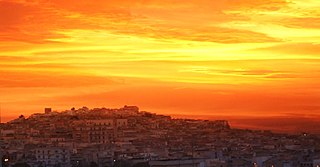
Canosa di Puglia, generally known simply as Canosa, is a town and comune in the province of Barletta-Andria-Trani, Apulia, southern Italy. It is located between Bari and Foggia, on the northwestern edge of the plateau of the Murgia which dominates the Ofanto valley and the extensive plains of Tavoliere delle Puglie, ranging from Mount Vulture at the Gargano, to the Adriatic coast. Canosa, the Roman Canusium, is considered the principal archaeological center of Apulia, and is one of the oldest continually inhabited cities in Italy. A number of vases and other archaeological finds are located in local museums and private collections. It is not far from the position on the Ofanto River where the Romans found refuge after the defeat of the Battle of Cannae and is the burial place of Bohemund I of Antioch.

The rood screen is a common feature in late medieval church architecture. It is typically an ornate partition between the chancel and nave, of more or less open tracery constructed of wood, stone, or wrought iron. The rood screen would originally have been surmounted by a rood loft carrying the Great Rood, a sculptural representation of the Crucifixion. In English, Scottish, and Welsh cathedrals, monastic, and collegiate churches, there were commonly two transverse screens, with a rood screen or rood beam located one bay west of the pulpitum screen, but this double arrangement nowhere survives complete, and accordingly the preserved pulpitum in such churches is sometimes referred to as a rood screen. At Wells Cathedral the medieval arrangement was restored in the 20th century, with the medieval strainer arch supporting a rood, placed in front of the pulpitum and organ.
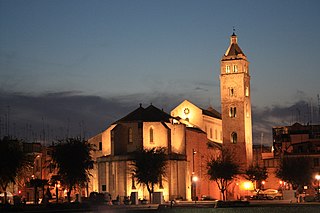
Barletta Cathedral is a Roman Catholic cathedral in Barletta, Apulia, southern Italy. Formerly the seat of the archbishops of Barletta and Nazareth, it is currently a co-cathedral in the Archdiocese of Trani-Barletta-Bisceglie. It was built in two different styles, Romanesque and Gothic, from the 12th century to the 14th century.

Sacred Heart Church is a Grade II listed redundant Roman Catholic church on Tyldesley Road, Hindsford, Atherton in Greater Manchester, England. It has been designated by English Heritage as a Grade II listed building.

The second St Mary's Roman Catholic Church is a heritage-listed sandstone Catholic church at 163 Palmerin Street in Warwick in the Southern Downs Region, Queensland, Australia. It was designed by Dornbusch & Connolly and built from 1920 to 1926. It is also known as St Mary of the Assumption Church. It was added to the Queensland Heritage Register on 21 October 1992.

St John's Anglican Church is a heritage-listed church at 153 Cunningham Street, Dalby, Western Downs Region, Queensland, Australia. It is the third church of that name on the site and was designed by Henry James (Harry) Marks and built in the 1920s. It is also known as St John's Church of England. It was added to the Queensland Heritage Register on 14 August 2008.

St Patrick's Cathedral is a heritage-listed Roman Catholic cathedral on James Street, South Toowoomba, Toowoomba, Toowoomba Region, Queensland, Australia. It was designed by Toowoomba architect James Marks and was built from 1883 to 1935. The site of the cathedral was originally a church and school known as St Patrick's Church School. In 1899, the school was moved to make way for the building of the cathedral and in 1959 renamed as St Saviour's School. St Patrick's Cathedral was added to the Queensland Heritage Register on 21 October 1992.

Holy Trinity Church is a heritage-listed Anglican church at 141 Brookes Street, Fortitude Valley, City of Brisbane, Queensland, Australia. It is the second church on that site. It was designed by Francis Drummond Greville Stanley built from 1876 to 1877 by James Robinson. It was modified in 1920–1921, 1925 and 1929. It was added to the Queensland Heritage Register on 21 October 1992.
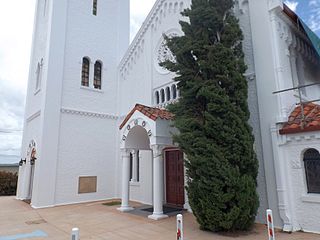
Holy Trinity Anglican Church is a heritage-listed Anglican church at 68 Hawthorne Street, Woolloongabba, Brisbane, Queensland, Australia. Since 1869, three church buildings have stood on this hill top site. The current church was completed in 1930. It was designed by the architect Eric Ford, featuring Romanesque and Spanish Mission Revival style architecture. Its preserved original architectural features make the church a traditional wedding venue of inner Brisbane. The church was added to the Queensland Heritage Register on 9 May 2008.

Our Lady of Victories Church is a heritage-listed Roman Catholic war memorial church at 29 Cintra Road, Bowen Hills, City of Brisbane, Queensland, Australia. It was designed by Hall & Prentice and built from 1919 to 1962. It is also known as White Temple of Peace. It was added to the Queensland Heritage Register on 11 November 1996.

St Patrick's Church is a heritage-listed Roman Catholic church at 58 Morgan Street, Fortitude Valley, City of Brisbane, Queensland, Australia. It was designed by Andrea Giovanni Stombuco and built from 1880 to 1882 by John Arthur Manis O'Keefe. It was added to the Queensland Heritage Register on 21 October 1992.

Corpus Christi Church is a heritage-listed Roman Catholic church at 65 Bage Street, Nundah, City of Brisbane, Queensland, Australia. It was designed by Hennessey, Hennessey, Keesing and Co and built from 1925 to 1926 by Stanley Samuel Carrick. It was added to the Queensland Heritage Register on 6 July 1995.

St. Procopius Church is a Roman Catholic church in Žďár nad Sázavou in the Czech Republic. It is protected as a cultural monument.

St Peter's Church is a Catholic church in Woolwich, South East London. It is situated between Woolwich New Road and Brookhill Road, the main entrance being on Woolwich New Road. The church was designed by Augustus Pugin in 1841–42 in the style of the Gothic Revival and is one of only three Pugin churches in London. Pugin's design remained unfinished as the projected tower and spire were never built. The parish of St Peter the Apostle serves the Catholic community of central Woolwich and surrounding areas, and is part of the Archdiocese of Southwark which is in the Province of Southwark.
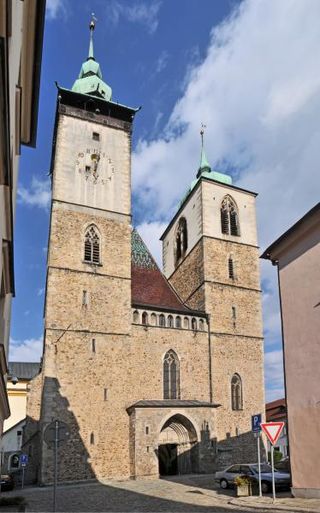
The Church of St. James the Great is an early Gothic church in Jihlava in the Czech Republic. It is a three-aisled temple nave with a long presbytery and two high towers in the front. It is consecrated to the patron of miners Saint James the Great.
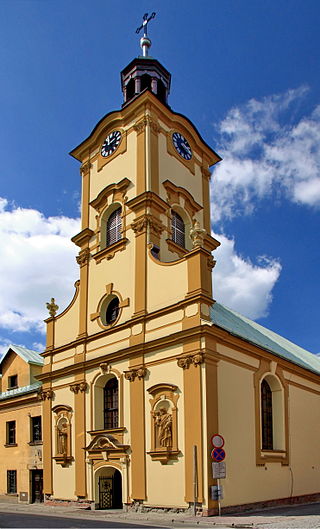
Holy Cross Church in Cieszyn is a Baroque church in Cieszyn, Poland, from the beginning of the 18th century. It is located in the city centre, on Szersznika street.

The Church of the Assumption of the Virgin Mary and St. Charles the Great is located in the Karlov area of Prague. The originally Gothic church was rebuilt and augmented in baroque style. The church is a part of the former convent of the Augustinian Order in Prague's Karlov.
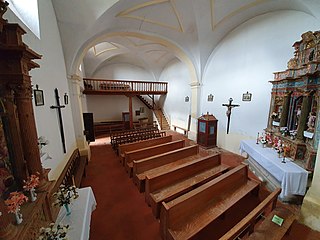
The Church of Our Lady of the Assumption, is a Catholic church located in Villamelendro de Valdavia, Spain. Originally built in the early twelfth century, the church's architecture is designed in a baroque style.
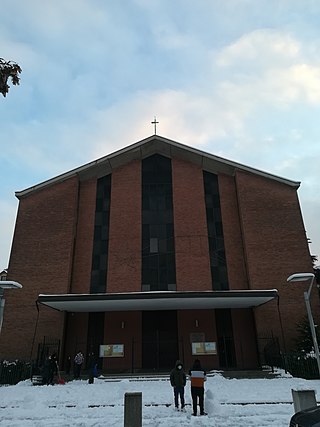
The Church of San Martino is a Catholic religious building located in Cinisello Balsamo, in Piazza Soncino, overlooking Villa Casati Stampa. It is the main church in the Balsamo area.






















